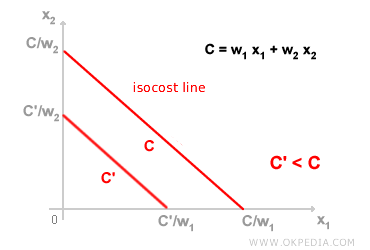Production Costs
Production costs refer to the expenses a company incurs to manufacture goods. These costs are influenced by the technology used in the production process and the company's organizational structure. In a competitive market, businesses strive to maximize profit by adopting the most efficient technology, enabling them to produce a given quantity at the lowest possible cost. Keeping costs down is a fundamental aspect of economic efficiency, alongside maximizing revenue. Given a production function with two input factors, X1 and X2, the total production cost C is expressed by the following equation:
C = w1 x1 + w2 x2
Here, x1 and x2 represent the quantities of input factors used in production, while w1 and w2 denote their respective unit costs. The total production cost C is the sum of the expenditures on each input: ( w1 x1 ) for the first factor and ( w2 x2 ) for the second. Different combinations of input factors that result in the same total cost C can be visually represented using an isocost line. Along an isocost line, the total cost remains unchanged.

A company's goal is to determine the most efficient mix of input factors ( x1, x2 ) that minimizes total cost C while maintaining a given level of output—this is known as optimal resource allocation. Identifying the ideal combination of inputs for each production level makes it possible to establish the cost function.
 Optimal Allocation. Analyzing production costs alone does not provide a definitive answer to the optimal allocation of input factors. In addition to cost considerations, output levels must also be taken into account. To determine the optimal allocation, both isocost lines and isoquant curves must be plotted on the same graph.
Optimal Allocation. Analyzing production costs alone does not provide a definitive answer to the optimal allocation of input factors. In addition to cost considerations, output levels must also be taken into account. To determine the optimal allocation, both isocost lines and isoquant curves must be plotted on the same graph.
